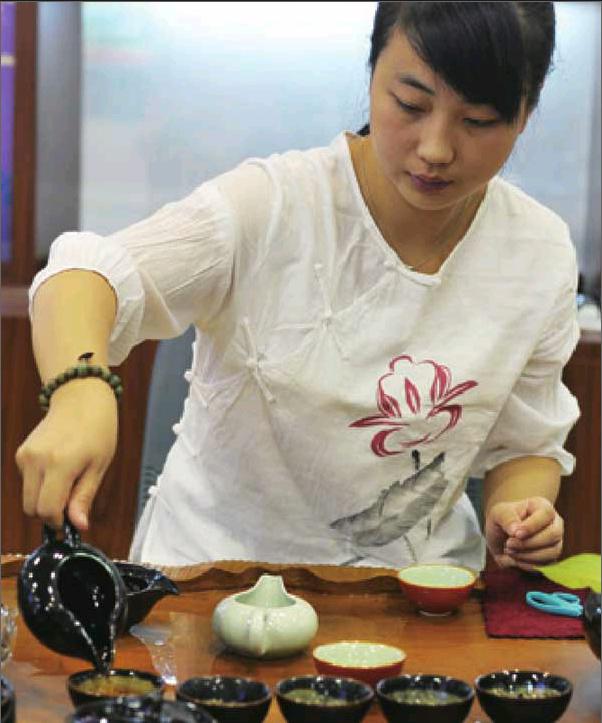FROM TE TO TEA
2016-08-17ByChenRan
By+Chen+Ran


A cup of hot oolong tea blended with the aroma of the sweet-scented osmanthus flower. That is a special drink Chen Guixiang makes for her customers. Both the tea and the flowers are grown in her familys own gardens in Anxi, a county in southeast Chinas Fujian Province, which is nicknamed the tea capital of China due to the wide variety of oolong tea it produces.
Chens tiny tea shop is located in the arcade of a three-storied Southeast Asian- style building near Zhongshan Road, the commercial heart of Xiamen, one of Fujians major cities as well as an important coastal city in China. The décor—from the copy of the celebrated Buddhist text Heart Sutra in Chinese hanging on the wall to the traditional teaware on display, wooden furniture and stone sculptures—makes her L-shaped shop an oasis of peace and calm. Her sister runs another tea shop a block away.
The bond of Chens family with tea be- gan with her great-great-grandfather in the late 19th century. All the family members would return home to help pick tea leaves and make tea during the harvest seasons every spring and autumn. Her father, 52-yearold Chen Shuiwang, invented a new flavor by blending oolong tea with osmanthus flowers.
Chen Guixiang and her friends have signed a contract with other local tea gardens to enlarge production. She has also introduced online marketing in the wake of e-commerce.
“Its been 10 years since my tea shop opened,” the 31-year-old explained. “My elderly neighbors, who are in their 80s or 90s, love to share their stories with me whenever they are drinking tea. Im not a local here, but I can tell how deep their love for the beverage is.”
Chen first worked as a kindergarten teacher, then as a human resources officer, then as an accountant. It was tea that pulled her back into the family business. Tea, in her eyes, is the healthiest drink in the world after water, opening up a deep-felt sense. “Before having a cup of good tea, you must clear your mind and calm down. Thats the secret to enjoy tea,” she said.
The cup that cheers
While the bond between Chens family and tea goes back generations, Xiamens status as a tea trade hub goes back centuries, as it used to be surrounded by major tea production bases.
Historically, tea was introduced to Europe in the early 17th century, when it was a rare luxury meant only for the rich. According to Old Xiamen, a book written by Dr. William Brown from Xiamen University, Amoy, as Xiamen was known in the past, had one of the worlds deepest natural harbors and was part of Zayton, the start of the Maritime Silk Road, since the Song Dynasty (960-1279).


“China is the home of tea. Tea was sent outside by sea from Amoy Port, and the name ‘tea came from the word used in the Amoy local dialect, te,” wrote Zhang Shuicun in Chinas Oolong Tea, the first book on the beverage published in China.
“To be honest, I just wanted to write articles about the tea I had been familiar with for decades. I didnt intend to write a book,” Zhang admitted. Starting from 1983, it took him 17 years to complete the 232-page book.
Born to a tea-making family in Anxi in 1927, Zhang moved to Xiamen at the age of 18 when the tea business operated by his father and uncles became the largest importer and seller in Burma (todays Myanmar). He was appointed manager at its Xiamen headquarters two years later. From private to state-owned enterprise, from state monopoly to market economy, Zhang, who improved the tea-brewing process by using coal instead of charcoal, witnessed the ups and downs of the local tea business for more than half a century. He passed away in 2015 at the age of 88.
Today, Fujian is the largest production base nationwide for oolong tea, one of the six major types of tea, and Xiamen remains the hub of Chinas tea trade. It is no wonder that it is the most popular beverage among people living in Xiamen. Drinking tea is part of their lives, just as coffee is in the West, and a tea set is the most common and frequently used item. There are over 6,000 tea shops and tea houses, big and small, scattered around Xiamen. Sumgo Tea is among the largest of them.
Lin Yuhui, Chairman of Sumgo Tea, also comes from a family with a long tea tradition. Owner of the largest local tea garden in Anxi, Lin, the eighth-generation successor of the tradition, started his business with two tiny tea shops in Xiamen in 2002. Today, the 40-year-old has a chain of 600-plus stores across China, with 20 stores in Xiamen alone.
Besides tea and teaware, Lins four-storied, well-designed flagship store also offers tea cuisine, tea ceremony presentations and tea culture workshops.
“Tea is more than a commodity. It carries ancient Chinese wisdom,” Lin said. “Once your mind is clear, your soul is calm, and your body stays healthy. I hope customers, especially young people, feel and learn the essence of Chinese virtues such as courtesy, respect and filial piety through tea ceremonies.”
Tea also means romance to him. “In my first tea shop years ago, I offered tea to a lady. Later, she became my wife,” he smiled.
Turning over a new leaf
In the wake of the 21st-Century Maritime Silk Road Initiative proposed by Chinese President Xi Jinping in 2013, coastal cities along the ancient trade route are striving for rejuvenation. Xiamen is no exception.
As early as 2003, the Xiamen Municipal Government adopted policies to promote the citys exhibition economy, the first of its kind nationwide. In 2009, the convention industry was also included for promotion.
“The convention and exhibition industry, as part of the service sector, plays an important role in the transformation [of the economy],”said Jeoven Wong, Director General of the Xiamen Municipal Bureau of Convention and Exhibition Affairs. “Xiamen is focusing on this industry, as well as the integration of related industries, and attaches great importance to supporting it.”
Last year, Xiamen played host to 193 exhibitions, attracting 1.35 million visitors. The convention and exhibition industry generated 31.8 billion yuan ($4.9 billion), a 15.1-percent increase year on year.
The China Xiamen International Tea Fair, started in 2010 and held every October, is becoming the worlds largest one-stop platform for the tea industry, encompassing everything from production, manufacturing, consumption and packaging to tea garden investments and cultural promotions.
Sumgo Tea, a regular at the fair, has utilized the networking opportunity to export tea to more than 50 countries.
“But, its a pity that most people dont have time to enjoy tea in a Chinese way,” Lin lamented. “I wish Chinese tea culture would reach more people.”
